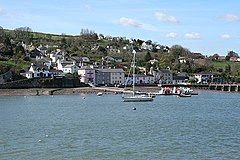Dittisham
| Dittisham | |
|---|---|
 Dittisham seen from Greenway Quay | |
Location within Devon | |
| Population | 424 (Parish) |
| OS grid reference | SX859552 |
| Civil parish |
|
| District | |
| Shire county | |
| Region | |
| Country | England |
| Sovereign state | United Kingdom |
| Police | Devon and Cornwall |
| Fire | Devon and Somerset |
| Ambulance | South Western |
Dittisham /ˈdɪtsəm/ is a village and civil parish in the South Hams district of the English county of Devon. It is situated on the west bank of the tidal River Dart, some 2 miles (3.2 km) upstream of Dartmouth.
The Greenway Ferry carries pedestrians across the river from Dittisham to Greenway Quay, adjacent to the Greenway Estate. Once the home of the crime writer Agatha Christie, this has views across the river, and the house and gardens are now owned by the National Trust and are open to the public.[1]
Gurrow Point is a private estate on the edge of Dittisham.
In 2001, the parish had a population of 424. The equivalent figures for 1801 and 1901 are 639 and 549.[2]
Dittisham has given its name to the Dittisham plum, a dessert variety grown here.
The fictitious Lady Dittisham is one of the main characters In Agatha Christie's Five Little Pigs.
Historic estates
The parish of Dittisham contains various historic estates including:
- Bosum's Hele (alias Bozun's Hele, Bozunsele, etc., modern: "Bozomzeal"), a former seat of the Bosom family. Sir Baldwin de Fulford (died 1476)[3] of Great Fulford in the parish of Dunsford, Devon, married Elizabeth[4][5] (or Jennet[6]) Bosum, daughter and heiress of John Bosum (alias Bosom, Bozun, Bosum, etc.) of Bosom's Hele,[5] by his wife Johane Fortescue.[4] Elizabeth Bozom survived her husband and married secondly to Sir William Huddesfield (died 1499), of Shillingford St. George, Devon, Attorney General to King Edward IV (1461–1483). Huddesfield married secondly (as her third husband) to Katherine Courtenay, a daughter of Sir Philip Courtenay (died 1463) of Powderham, Devon. A monumental brass of Huddesfield and his second wife Katherine Courtenay survives in Shillingford St George Church,[7] and the arms of Bosome (Azure, three bird bolts in pale points downward or) survive in a stained glass window in the same church.[8] By Jennet Bosome, heiress of Bozum's Hele,[9] he had children two sons and two daughters, namely Thomasine Fulford, who married John Wise of Sydenham House, from whom was descended John Russell, 1st Earl of Bedford (c. 1485 – 1555), the most powerful magnate in Devon, and another daughter Alice Fulford, who married Sir William Cary of Cockington, from whom was descended Lord Hunsdon and the Earls of Monmouth and Dover.[10] His younger son was John Fulford (died 1518), a Canon of Exeter Cathedral and Archdeacon successively of Totnes, Cornwall and Exeter, whose large black marble ledger stone survives in Exeter Cathedral, behind the high altar[6] The manor of Bosom's Hele was inherited by the Fulford family[11] and the arms of Bozom appear in the 5th quarter of the 16th century relief sculpted escutcheon over the main entrance to Great Fulford House.
References
- ^ "Dittisham Departures". Greenway Ferry Service. Archived from the original on 15 May 2008. Retrieved 24 September 2008.
- ^ "Census statistics 1801-2001 Devon parishes D". Devon County Council. 18 June 2007. Archived from the original on 11 October 2008. Retrieved 21 September 2008.
- ^ Prince, John, (1643–1723) The Worthies of Devon, 1810 edition, London, p.394
- ^ a b Vivian, p.127
- ^ a b Risdon, pp. 167–8; Pole, p.291
- ^ a b Vivian, p.378
- ^ Pevsner, Nikolaus & Cherry, Bridget, The Buildings of England: Devon, London, 2004, p.727; a framed rubbing of the brass hangs in the chapel of Powderham Castle
- ^ Rogers, William Henry Hamilton, Wilshire Notes & Queries, Vol.III, 1899-1901, Devizes, 1902, pp. 336–345, Sir William Huddesfield and Katherine Courtenay his Wife, Shillingford Church, Devon[1]
- ^ Risdon, p.168: "This land descended unto Sir Francis Fulford"
- ^ Prince, p.394
- ^ Risdon, p.168: "This land descended unto Sir Francis Fulford"; Pole, p.291
External links

